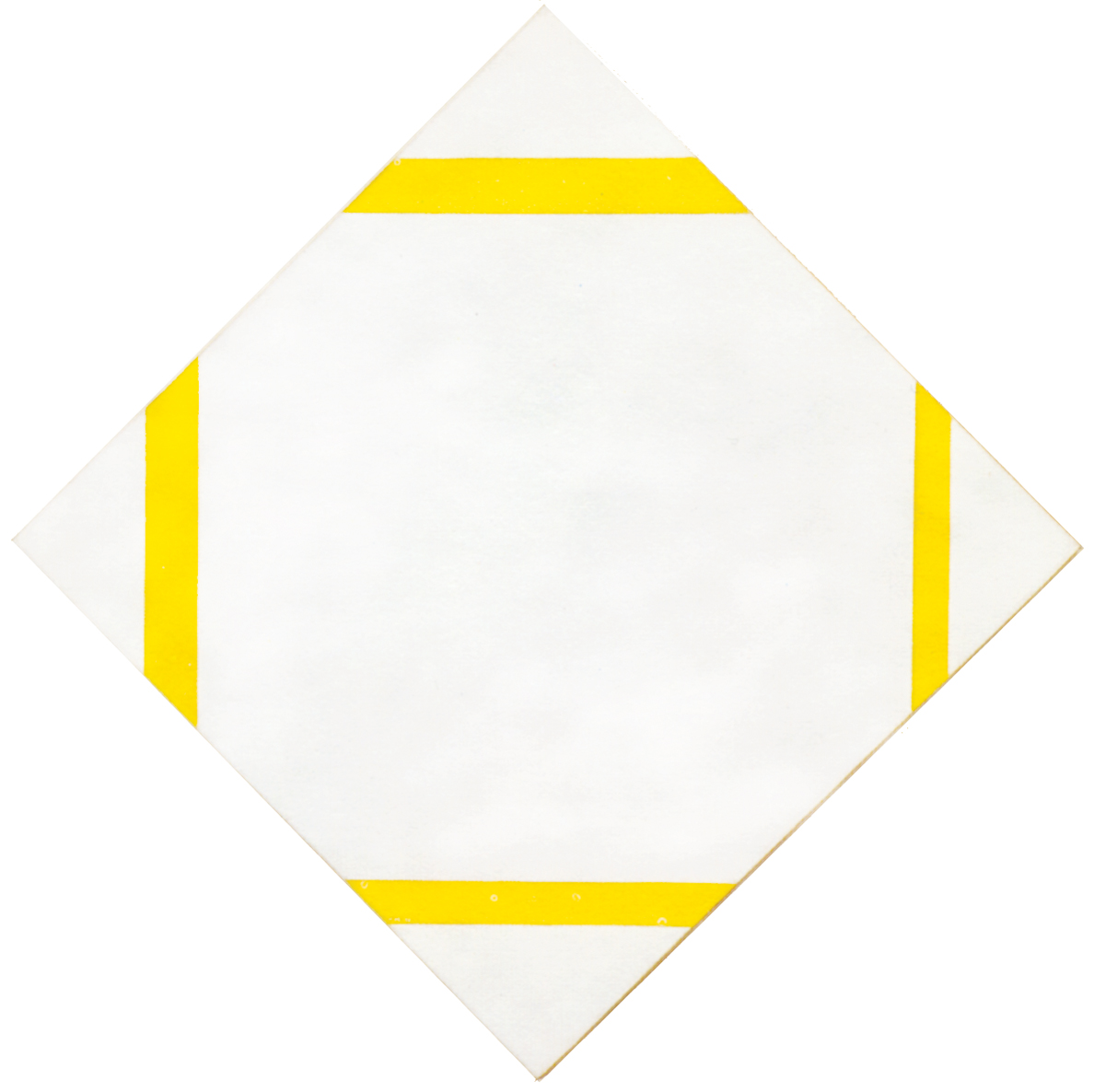A relational space
In his pursuit of a new plastic art, Piet Mondrian progressively identified the spiritual with the vertical and the natural with the horizontal in order to create a relational space in the two dimensions of the canvas between what he, like every human being, felt to be contrasting realities such as, for instance, the infinite extension of nature and the finite human environment or the controversial relationship between the natural instincts and reason that animates the inner life of human beings.
This should not, however, be taken as an attribution of objective value.
The vertical could function equally well as a symbol of the natural, in which case the horizontal would come to symbolize the spiritual.
Natural space is of course presented to the eye as a boundless horizontal expanse (especially in the Netherlands) whereas the vertical aptly expresses the human desire to concentrate within himself the variety of the physical world ideally, conceiving it as a whole. A vertical thrust expresses mankind’s atavistic propensity to imagine the spiritual as an invisible reality extending toward the ethereal space of the heavens rather than remaining bound to the everyday matter spread out before our eyes.
All this may have influenced the artist in his attribution of meaning, but not to any great extent. After all, Mondrian’s aim was to express an equivalence of opposites such as unity and multiplicity, spirit and matter, interior and exterior.
Horizontal and vertical have no inherent value in Neoplastic space. They serve as visual metaphors of the duality present in the human mind and as an abstract symbol of opposite natural forces that clash and relate with one another to generate all the variety of the world.
Not a grid
The perpendicular lines of Neoplastic space are not designed to create a “cross” or what certain art critics call a “grid”. They should not be seen as the representation of objects but as the expression of a dynamic flow encompassing every possible object viewed from every possible position.
Mondrian: “Everything is expressed through relations. Color, size, and position exist only through opposition to a different color, size, and position. This is why I call the relationship the fundamental element. (…) Each thing becomes knowable only through another, as every form of wisdom teaches us.”
Still too often we look at an abstract composition looking for direct references in it to the common appearance of things. On the other side of the Atlantic Ocean abstraction is regarded with superficiality as one of the many possible styles or schools of modern art. The truest and deepest meaning of the process that revolutionized the language of European painting during the first half of the 20th century has yet to be fully understood in the New World.
We shall also have to wait some time for people to stop seeing Neoplastic lines solely as rigid reticular structures and sterile geometric schemata. I am afraid that these schemata are in actual fact located in their own minds: when they are careful not to give way too much to emotion; when they endeavor to control the unpredictable flux of existence by planning every aspect of their lives.
The inner lives of certain human beings are so controlled that when they turn to look at art, they prefer forms of visceral expression. They cannot bear to add one more straight line to all the ones already present in their heads. Art becomes an escape from themselves and from reality.
I instead believe that art must tackle reality in all its aspects. Neoplasticism urges us to consider the human being as a whole, simultaneously visceral and rational, in order to find equilibrium between the contradictory aspects of the life, between instinct and reason, nature and thought.
Humanistic and scientific thought
On thinking for a moment about our common experience of life, we realize that the preliminary choice of “straight” paths enables us to move more easily through the unpredictable twists and turns of existence. It is through “lines” that the designing mind, out of which science and technology are generated, expresses itself. This does not, however, alter the fact that lines are successfully used in Broadway Boogie Woogie to express a vision of greater breadth rising from the particular and the precise to the universal and the imponderable.
Humanistic thought and scientific thought will never be brought together unless we succeed in expressing the unpredictable and indeterminate aspect of nature and human existence with determinate means of expression. In no way does this mean reducing everything to the rational sphere.
Mondrian’s work demonstrates that a clear and precise visual alphabet does not make it impossible to express the mysterious as long as one has a broader vision of things and the ability to place that alphabet at its service. We are reminded of Italo Calvino‘s remark about “expressing the indefinite with the definite and the inexact with the utmost precision.”
Time and teaching
I am afraid that time and a great deal of teaching will still be needed to make people understand the degree of mental openness and emotional transport that should actually be involved in the enjoyment of Neoplasticism.
The orthogonal lines and primary colors are an act of autonomy and freedom of thought with respect to nature, not an imposition. Though it might at first seem an arbitrary and restrictive choice with respect to the natural world, the Neoplastic language then strives to reformulate as exhaustively as possible the real and not merely apparent characteristics of natural space, or rather the characteristics of the relationship between thought and nature, finally treating the two aspects as essential components of a single and indissoluble process.
back to reflections
Copyright 1989 – 2025 Michael (Michele) Sciam All Rights Reserved More
